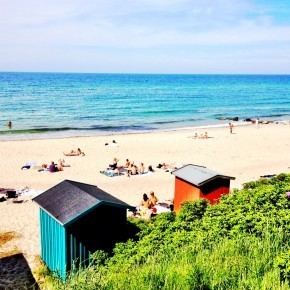Local time Saturday 9:20 PM | ||
 | ||
Weather 11°C, Wind S at 5 km/h, 80% Humidity | ||
Tisvilde is a small town with a population of 1,537 (1 January 2014) located on the north coast of the island Zealand (Sjælland) in Denmark 60 km (37 mi) in Gribskov Municipality, northeast of Hillerød.
Contents
- Map of 3220 Tisvilde Denmark
- Etymology
- Tisvilde Hegn
- Springs
- Manmade
- Events and activities
- Notable people
- Literature
- References
Map of 3220 Tisvilde, Denmark
Tisvildeleje is the coastal part of Tisvilde. "Leje" roughly translates as 'plain' and used to be a fishermans village. Now most of the fishermen's houses are used as charming summer residences. The southeast of Tisvilde is referred to as Tibirke.
Etymology
The name Tisvilde broken down to Tis-vilde, means "Ti's vælde" and have many interpretations. It can be understood as Where Tyr Reigns and the area is conceived as dedicated to the god Tyr in former ages. Ti is a common word for Tir (Týr) in Danish place names and can also mean God, without being specific about what God. "Væld" also means a spring and that spring is believed to be the spring known as Helene Spring nowadays. In addition "Væld" is also referring to the old Nordic word "ved" or "wald" meaning Forest. Tisvilde was previously covered by extensive oak woods, before the sand drifts began. So all in all, Tisvilde has three parallel meanings: Where Tyr Reigns, Tyrs Spring and Tyrs Forest.
The word Leje is used in several other place names in Denmark, such as Liseleje west of Tisvildeleje or Rågeleje and Gilleleje to the east.
Tisvilde Hegn
From around 1500, drifting sands began to bury the fields and farms around Tisvilde. The problem accelerated over the years and by 1700, most of the area had been deserted. Several attempts to counter the forces of nature, had been tried, but in 1724 the German Johan Ulrich Røhl was hired by the Crown and by help of the local peasants and 100 soldiers from Copenhagen, they managed to stop the dunes in the course of the 1730s, by covering them with seaweed and digging trenches. But while the dunes was successfully stopped in their march against civilisation, the sands had covered and transformed the countryside and made it completely barren. From around 1800 to 1900 this state was reversed, by planting the c. 1,300 ha forest of Tisvilde Hegn in association with the plantations of Asserbo and Liseleje southwest. The first tree species to be planted was scots pine and later followed by spruce, birch, beech and oak. Tisvilde Hegn is the oldest plantation in Denmark and now a Natura 2000 area, due to its rare habitat-types, flora and fauna and important birdlife. Some of the species to be protected here is northern crested newt and large white-faced darter.
The coastline at Tisvilde Hegn is known for its stretches of white, clean and child-friendly sandy beaches.
Springs
Manmade
Events and activities
Being a popular summer destination for tourists, the level of activity is at its peak during the summer months. Examples are:
Notable people
Two Danish Nobel laureates, the scientist Niels Bohr and the writer Johannes V. Jensen, both lived in Tisvilde for extended periods of time. Other notable people who lived in Tisvilde include the painter William Scharff and the composer Knudåge Riisager.
